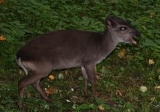
Blue Duiker
Encyclopedia
Blue Duiker is a small forest dwelling duiker
found in the Central Africa
and southern South Africa
.
Blue Duikers stand around 35 centimetres tall at the shoulder and weigh 4 kilograms.They are the smallest of the antelope family. Blue Duikers have a brown coat with a slight blue tinge – hence their name – and a white underside. There is a glandular slit beneath both eyes and a very slight crest between the ears. Blue Duikers have simple conical horns of 2 to 10 centimetres. Females don't always have horns.
Blue Duiker live mainly in rainforest
s, where they eat fruit
, flower
s and leaves
, which have fallen from the canopy
as well as eggs
, and insect
s. It is, in turn, the prey of the Crowned Eagle
. Blue Duiker are nocturnal and solitary or form mating pairs. They are very territorial animals, patrolling the borders of their territory and marking it with their dung and excretions from glands above their hooves and under their eyes. They will chase off any intruders and only tolerate their children's presence until they reach 18 months.
Blue Duiker generally produce 1 offspring per year. Gestation is estimated at between 4 and 7.5 months.
Blue Duiker are not at all endangered and are in fact quite common – in Gabon
they can reach population densities of almost 80 animals per square kilometre.
Duiker
A duiker is any of about 21 small to medium-sized antelope species from the subfamily Cephalophinae native to Sub-Saharan Africa.Duikers are shy and elusive creatures with a fondness for dense cover; most are forest dwellers and even the species living in more open areas are quick to disappear...
found in the Central Africa
Central Africa
Central Africa is a core region of the African continent which includes Burundi, the Central African Republic, Chad, the Democratic Republic of the Congo, and Rwanda....
and southern South Africa
South Africa
The Republic of South Africa is a country in southern Africa. Located at the southern tip of Africa, it is divided into nine provinces, with of coastline on the Atlantic and Indian oceans...
.
Blue Duikers stand around 35 centimetres tall at the shoulder and weigh 4 kilograms.They are the smallest of the antelope family. Blue Duikers have a brown coat with a slight blue tinge – hence their name – and a white underside. There is a glandular slit beneath both eyes and a very slight crest between the ears. Blue Duikers have simple conical horns of 2 to 10 centimetres. Females don't always have horns.
Blue Duiker live mainly in rainforest
Rainforest
Rainforests are forests characterized by high rainfall, with definitions based on a minimum normal annual rainfall of 1750-2000 mm...
s, where they eat fruit
Fruit
In broad terms, a fruit is a structure of a plant that contains its seeds.The term has different meanings dependent on context. In non-technical usage, such as food preparation, fruit normally means the fleshy seed-associated structures of certain plants that are sweet and edible in the raw state,...
, flower
Flower
A flower, sometimes known as a bloom or blossom, is the reproductive structure found in flowering plants . The biological function of a flower is to effect reproduction, usually by providing a mechanism for the union of sperm with eggs...
s and leaves
Leaf
A leaf is an organ of a vascular plant, as defined in botanical terms, and in particular in plant morphology. Foliage is a mass noun that refers to leaves as a feature of plants....
, which have fallen from the canopy
Canopy (forest)
In biology, the canopy is the aboveground portion of a plant community or crop, formed by plant crowns.For forests, canopy also refers to the upper layer or habitat zone, formed by mature tree crowns and including other biological organisms .Sometimes the term canopy is used to refer to the extent...
as well as eggs
Egg (biology)
An egg is an organic vessel in which an embryo first begins to develop. In most birds, reptiles, insects, molluscs, fish, and monotremes, an egg is the zygote, resulting from fertilization of the ovum, which is expelled from the body and permitted to develop outside the body until the developing...
, and insect
Insect
Insects are a class of living creatures within the arthropods that have a chitinous exoskeleton, a three-part body , three pairs of jointed legs, compound eyes, and two antennae...
s. It is, in turn, the prey of the Crowned Eagle
Crowned Eagle
The Crowned Eagle or Crowned Hawk-eagle , is a very large, powerful, crested bird of prey found in sub-Saharan Africa; in Southern Africa it is restricted to suitable habitat in the eastern areas. It is the only extant member of the genus Stephanoaetus...
. Blue Duiker are nocturnal and solitary or form mating pairs. They are very territorial animals, patrolling the borders of their territory and marking it with their dung and excretions from glands above their hooves and under their eyes. They will chase off any intruders and only tolerate their children's presence until they reach 18 months.
Blue Duiker generally produce 1 offspring per year. Gestation is estimated at between 4 and 7.5 months.
Blue Duiker are not at all endangered and are in fact quite common – in Gabon
Gabon
Gabon , officially the Gabonese Republic is a state in west central Africa sharing borders with Equatorial Guinea to the northwest, Cameroon to the north, and with the Republic of the Congo curving around the east and south. The Gulf of Guinea, an arm of the Atlantic Ocean is to the west...
they can reach population densities of almost 80 animals per square kilometre.

